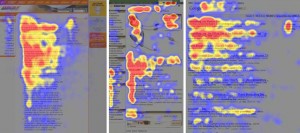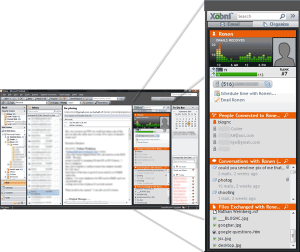The truth is people don’t read very much, often scanning text instead of really reading it. On the average Web page, users have time to read at most 28% of the words during an average visit; 20% is more likely. This is at least what recent eyetracking studies showed.
In the study, the authors instrumented 25 users’ browsers and recorded extended information about everything they did as they went about their normal Web activities.
Among other things, the authors found that the Back button is now only the 3rd most-used feature on the Web. Clicking hypertext links remains the most-used feature, but clicking buttons (on the page) has now overtaken Back to become the second-most used feature. The reason for this change is the increased prevalence of applications and feature-rich Web pages that require users to click page buttons to access their functionality.
So, what do people really see on a page? Eyetracking visualizations show that users often read Web pages in an F-shaped pattern: two horizontal stripes followed by a vertical stripe.

Users first read in a horizontal movement, usually across the upper part of the content area. This initial element forms the F’s top bar.
Next, users move down the page a bit and then read across in a second horizontal movement that typically covers a shorter area than the previous movement. This additional element forms the F’s lower bar.
Finally, users scan the content’s left side in a vertical movement. Sometimes this is a fairly slow and systematic scan that appears as a solid stripe on an eyetracking heatmap. Other times users move faster, creating a spottier heatmap. This last element forms the F’s stem.
Click here for full results survey results about the F-shaped pattern.
Other interesting results:
Banner ad blindness: Users rarely look at display advertisements on websites. Of the four design elements that do attract a few ad fixations, one is unethical and reduces the value of advertising networks.
Fancy formatting is ignored: One site did most things right, but still had a miserable 14% success rate for its most important task. The reason? Users ignored a key area because it resembled a promotion.
Numbers are better then letter: It’s better to use “23” than “twenty-three” to catch users’ eyes when they scan Web pages for facts, according to eyetracking data.
Talking heads are boring: Eyetracking data show that users are easily distracted when watching video on websites, especially when the video shows a talking head and is optimized for broadcast rather than online viewing.
